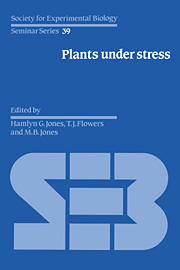Book contents
- Frontmatter
- Contents
- Contributors
- Preface
- 1 Introduction: some terminology and common mechanisms
- 2 The impact of environmental stresses on ecosystems
- 3 Whole-plant responses to stress in natural and agricultural systems
- 4 Photosynthesis and gas exchange
- 5 Regulation of growth and development of plants growing with a restricted supply of water
- 6 Stresses, membranes and cell walls
- 7 Desiccation injury, anhydrobiosis and survival
- 8 Molecular biology: application to studies of stress tolerance
- 9 Environmental control of gene expression and stress proteins in plants
- 10 Plant tissue and protoplast culture: applications to stress physiology and biochemistry
- 11 Breeding methods for drought resistance
- 12 Selection for physiological characters – examples from breeding for salt tolerance
- 13 Prospects for improving crop production in stressful environments
- Index
11 - Breeding methods for drought resistance
Published online by Cambridge University Press: 16 March 2010
- Frontmatter
- Contents
- Contributors
- Preface
- 1 Introduction: some terminology and common mechanisms
- 2 The impact of environmental stresses on ecosystems
- 3 Whole-plant responses to stress in natural and agricultural systems
- 4 Photosynthesis and gas exchange
- 5 Regulation of growth and development of plants growing with a restricted supply of water
- 6 Stresses, membranes and cell walls
- 7 Desiccation injury, anhydrobiosis and survival
- 8 Molecular biology: application to studies of stress tolerance
- 9 Environmental control of gene expression and stress proteins in plants
- 10 Plant tissue and protoplast culture: applications to stress physiology and biochemistry
- 11 Breeding methods for drought resistance
- 12 Selection for physiological characters – examples from breeding for salt tolerance
- 13 Prospects for improving crop production in stressful environments
- Index
Summary
Introduction: improvement of drought resistance in conventional breeding programmes
Critical evaluation of progress in plant breeding over a period of several decades (e.g. Wilcox et al., 1979; Castleberry, Crum & Krull, 1984) has demonstrated a genetic improvement in yield under both favourable and stress conditions. The yield improvement under drought stress occurred before many of the physiological issues of drought resistance were understood and resulted partly from the genetic improvement of yield potential and partly from the improvement of stress resistance. For example, Bidinger et al. (1982) found that the yield of millet varieties under drought stress was largely explained by their yield potential and growth duration. Early varieties with a high yield potential were most likely to yield best under stress. Fischer & Maurer (1978) also recognised the effect of potential yield on yield performance of wheat under drought stress and proposed a ‘susceptibility index’ (5) which estimated the relative susceptibility of a variety to drought stress. In analysing their wheat data, they found that S was not totally independent of the potential yield of the variety.
The improvement of yield under stress must therefore combine a reasonably high yield potential (Blum, 1983) with specific plant factors which would buffer yield against a severe reduction under stress. On the other hand, potentially lower yielding genotypes occasionally have been found to perform very well under drought stress conditions (e.g. Blum, 1982; Ceccarelli, 1987), especially under severe drought stress. One is left with the long-standing practical conclusion of Reitz (1974) that ‘Varieties fall into three categories: (a) those with uniform superiority over all environments; (b) those relatively better in poor environments; and (c) those relatively better in favoured environments’.
- Type
- Chapter
- Information
- Plants under StressBiochemistry, Physiology and Ecology and their Application to Plant Improvement, pp. 197 - 216Publisher: Cambridge University PressPrint publication year: 1989
- 16
- Cited by

